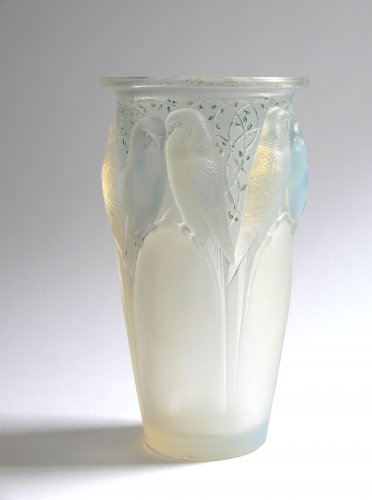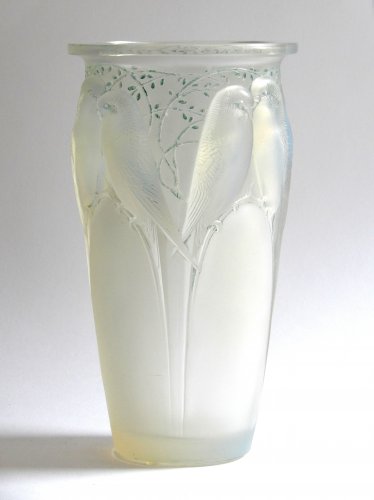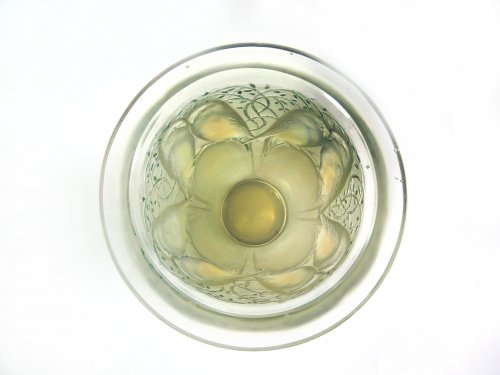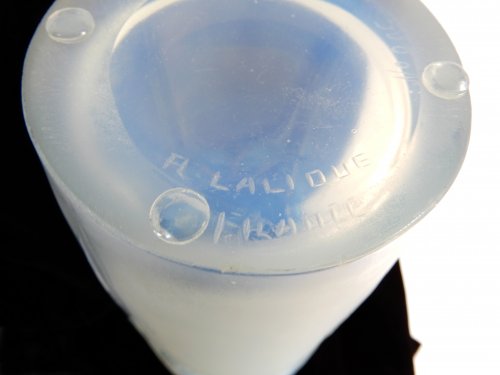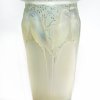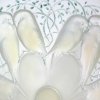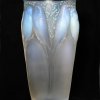René Lalique (1860-1945) Vase 'Ceylan'
About this piece
A famous vase, 'Ceylan' or also called 'Huit perruches', designed by René Lalique in 1924. This vase, executed in opalescent glass, got a high level of yellow, which is a wanted colour in opalescent glass. Under light, the opalescent glass changes his colour in several varieties from blue to golden yellow. A lot of craftmanship and technical knowledge was needed, to make a vase like this.
The vase is signed with 'R. Lalique, France'.
The vase is introduced in 1924 and made of pressed frosted glass and partly stained in a green/blue colour. The 'Ceylan' vase with modelnumber 905, was in the catalogue of 1928 and 1932. In 1937 only available from stock.
Biography:
René Lalique was active as an apprentice jeweller at age 16. After been 2 years in England as a apprentice, he started his own business,in 1880, as a jewellery designer. He soon became a success, especially after he participated at the Universal Exhibition of 1900 in Paris. Thereafter his name was definitively established.
From 1890 he was also very interested in glass. He adapted glass in his designs. He soon expanded his work with the proper tools and equipment, and also increased his knowledge, especially in the field of colouring and moulds. In 1905 he received orders from François Coty to design various perfume bottles, he experimented with new styles and techniques. During that time he started to work with moulds and pressed glass. In 1912 he started his 2nd career as a master glass artist. He once said that he would create something so special that's not been seen before. Which he certainly succeeded.
He then made except small glass objects such as jewellery and perfume bottles, major works as vases, lamps, tableware, clocks, car mascots, but also architectural glass applications such as door handles, wall panels etc.
After WWI, the French government offered him for not much money a factory in the Elzas, the Elzas was French again. He built a new glass factory in Wingen-sur-Moder where he produced most of his pressed glass vases. Mid 1930's he closed his factory in Paris and everything was produced in Wingen-sur-Moder, till now. After his death in 1945, his family continued the company.
He is seen as one of the largest glass artists in the world. His work is admired worldwide in museums, there are also several museums that are only dedicated to René Lalique, such as Lalique Museum Doesburg in the Netherlands and ofcourse Musée Lalique in Wingen-sur-Moder, but also in Hakone and many others.
Literatuur:
- Félix Marcilhac, ‘R. Lalique, Catalogue raisonné de l’oeuvre de verre’, Les Éditions de l’Amateur, Paris 2011, p. 418, modelnummer 905.
- Christopher Vane Percy; 'The glass of Lalique, a collectors guide', Studio Vista, Cassell & Collier Macmillan Publishers Ltd, London, 1977. P. 40 (photo) & 148.
- Philippe Olland; 'Dictionnaire des Maîtres Verriers de l'Art Nouveau á l'Art Déco, Marques & signatures'. Éditions Faton 2016. P. 192-199.
- Victor Arwas, 'Glass, Art Nouveau to Art Deco'. Academy Editions London 1987.
Condition
Goed, paar kleine luchtbelletjes.
Material:
Glass
Measurements:
Height: 25 cm
(9,84")
Year:
Ontwerp 1924
Period:
Ontwerp 1924
Origin:
France
Artist / atelier:
René Lalique,

